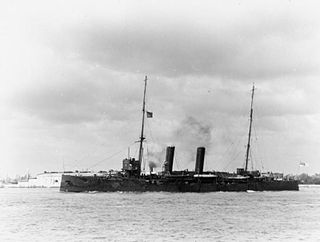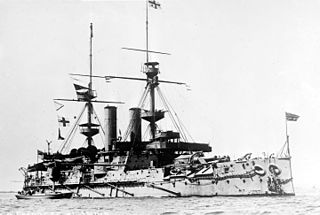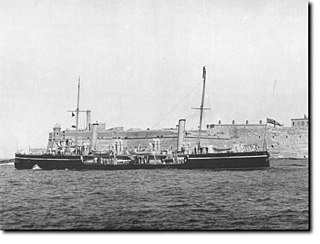
HMS Sans Pareil was a Victoria-class battleship of the British Royal Navy of the Victorian era, her only sister ship being HMS Victoria.

HMS Hawke, launched in 1891, was the seventh British warship to be named Hawke. She was an Edgar-class protected cruiser. In September 1911 the Hawke collided with the ocean liner RMS Olympic. The damage smashed the Hawke's bow and damaged the stern of the Olympic.

HMS Kingfisher was a Doterel-class screw sloop of the Royal Navy. She was built at Sheerness Dockyard and launched on 16 December 1879. She conducted anti-slavery work in the East Indies in the late 1880s before being re-roled as a training cruiser, being renamed HMS Lark on 10 November 1892, and then HMS Cruizer on 18 May 1893. She was sold in 1919.
HMS Panther was a B-class torpedo boat destroyer of the British Royal Navy. She was completed by Laird, Son & Company, Birkenhead, in 1897.

HMS Blenheim was a Blake-class first class protected cruiser that served in the Royal Navy from 1890 to 1926. She was built by Thames Ironworks & Shipbuilding Company at Leamouth, London. The ship was named after the Battle of Blenheim.

HMS Amphitrite was a ship of the Diadem-class of protected cruisers in the Royal Navy, which served in the First World War.

HMS Andromeda was one of eight Diadem-class protected cruisers built for the Royal Navy in the 1890s. Upon completion in 1899, the ship was assigned to the Mediterranean Fleet where she helped to escort a royal yacht during its cruise through the Mediterranean Sea. After a refit, she was assigned to the China Station in 1904 and returned home three years later to be reduced to reserve. Andromeda was converted into a training ship in 1913 and remained in that role under various names until 1956. That year she was sold for scrap and broken up in Belgium, the last Pembroke-built ship still afloat.

HMS Blake, named in honour of Admiral Robert Blake, was the lead ship of her class of protected cruiser that served in the Royal Navy from 1889 to 1922.

HMS Sappho was an Apollo-class cruiser of the British Royal Navy which served from 1892 to 1918 in various colonial posts.

HMS Empress of India was one of seven Royal Sovereign-class pre-dreadnought battleships built for the Royal Navy during the 1890s. The ship was commissioned in 1893 and served as the flagship of the second-in-command of the Channel Fleet for two years. She was transferred to the Mediterranean Fleet in 1897, during which time Empress of India was assigned to the International Squadron blockading Crete during the uprising there. She returned home in 1901 and was briefly assigned as a coast guard ship in Ireland before she became the second flagship of the Home Fleet. The ship was reduced to reserve in 1905 and accidentally collided with the submarine HMS A10 the following year. Empress of India was taken out of service in early 1912 and accidentally struck a German sailing ship while under tow. She was sunk as a target ship in 1913.

HMS Duncan was the lead ship of the six-ship Duncan class of Royal Navy pre-dreadnought battleships. Built to counter a group of fast Russian battleships, Duncan and her sister ships were capable of steaming at 19 knots, making them the fastest battleships in the world. The Duncan-class battleships were armed with a main battery of four 12-inch (305 mm) guns and they were broadly similar to the London-class battleships, though of a slightly reduced displacement and thinner armour layout. As such, they reflected a development of the lighter second-class ships of the Canopus-class battleship. Duncan was built between her keel laying in July 1899 and her completion in October 1903.

HMS Sparrow was a Redbreast-class gunboat launched in 1889, the sixth Royal Navy ship to bear the name. She became the New Zealand training ship NZS Amokura in 1906 and was sold in 1922.

HMS Fantome was an Cadmus-class sloop launched in 1901, transferred to the Royal Australian Navy in 1914, returned to the Royal Navy in 1920, and sold in 1924. She was the fourth ship of the Royal Navy to bear the name, which is from the French fantôme, meaning "ghost".

The sixth HMS Harrier was a Dryad-class torpedo gunboat. She was launched at Devonport Dockyard on 20 February 1894, and saw service in the Mediterranean and in fishery protection. She served as a minesweeper during World War I and was sold for commercial use in 1920.

HMS Icarus was a Mariner-class composite screw gunvessel of 8 guns, and the third Royal Navy vessel to carry the name. She was launched in 1885 at Devonport and sold in 1904.

HMS Pandora was a Pelorus-class cruiser of the Royal Navy. There were eleven "Third class" protected cruisers in the class, which was designed by Sir William White. While well armed for their size, they were primarily workhorses for the overseas fleet on "police" duties and did not serve with the main battlefleet.

HMS Prometheus was a Pelorus-class protected cruiser of the Royal Navy. Ten sister third class protected cruisers were built — designed by Sir William White. While well-armed for their size, they were primarily workhorses for the overseas fleet considered to be on police duties. She was sold for scrap in 1914.

HMS Venus was an Eclipse-class protected cruiser built for the Royal Navy in the mid-1890s.

HMS Isis was an Eclipse-class protected cruiser built for the Royal Navy in the mid-1890s.
Vice-Admiral Gerald Charles Adolphe Marescaux was a Royal Navy and British Army officer. Having joined the navy in 1873, Marescaux spent the majority of his time as a junior officer serving on surveying duties. Promoted to commander in 1896, he served as captain of ships undergoing trials at Sheerness until 1900. He was promoted to captain in 1903 and held commands at home and on the China Station before in 1910 he took command of the North of Ireland Coastguard. In 1913 he was made King's Harbour Master, Portland, and promoted to rear-admiral.



















